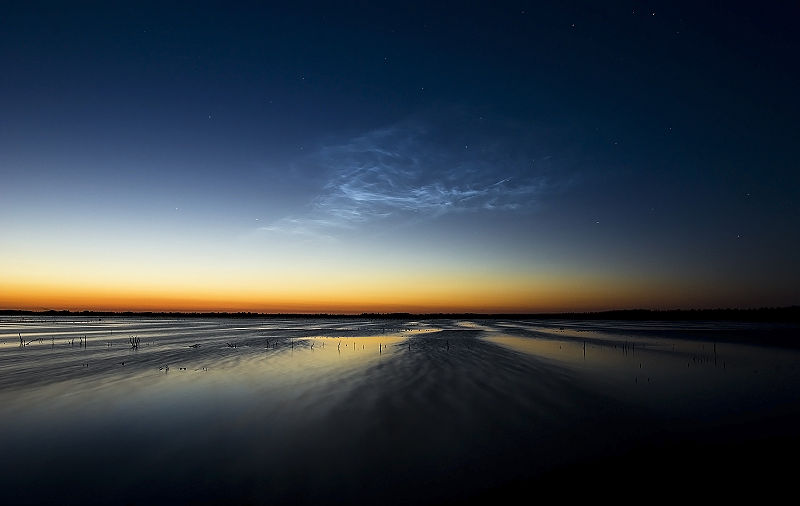Noctilucent Clouds - Planet Earth Online
Interview with
David - Noctilucent clouds are one of the rarest clouds that you are likely to see in the atmosphere, but at the same time it is something anybody - if they know when to go and look - can see. They form up at about 85 kilometres which is very high up in the atmosphere. Most of the clouds you see day to day will only be in the lowest few kilometres and certainly not above 15 kilometres. So they're really much, much higher. The other thing is they only form during the midsummer months of June and July and what we would say is a middle and upper latitude, so anywhere in the British Isles you have the chance to see these and you need to wait until the sun has set and has gone a bit below the horizon, so dawn and dusk during the midsummer months that's the time to go and see noctilucent clouds.
Sue - How can you tell a noctilucent cloud from say a cumulous cloud that everybody is familiar with - the fluffy one?
David - You need to wait for the sun to set below the horizon. 85 kilometres - it takes a lot longer for the sun to set than it does on the ground so you need  to wait maybe half an hour an hour after sunset. The word noctilucent itself means night shining. These clouds look sort of silvery, they're often very thin filament structures and you will see them glowing whereas the lower clouds, the typical clouds, you will see will tend to be quite grey by then if there are any.
to wait maybe half an hour an hour after sunset. The word noctilucent itself means night shining. These clouds look sort of silvery, they're often very thin filament structures and you will see them glowing whereas the lower clouds, the typical clouds, you will see will tend to be quite grey by then if there are any.
Sue - You've got a picture for me here on your computer screen and you are right they are white and shiny and wispy and threadlike.
David - They do tend to be very characteristic and all these small filaments are quite important. That said it sometimes is possible to confuse a regular cloud with a noctilucent cloud but if you've got nominally clear skies you will know if you do see a good example.
Sue - Why study these particular clouds?
David - These clouds are interesting because they are in part of the atmosphere where it's quite hard to study anyway. So, clouds even low down, by watching what clouds are doing it can tell you a bit about the atmosphere, but the other reason they are particularly of interest to scientists is nobody ever saw them or reports having seen them before, I think, it's 1883 which was the time of the eruption of Krakatau and within a year or so of that people started to report sightings of these and there are indications that maybe they're becoming more common and there is a bit of a suspicion that that could represent some indication of a change in climate up in the high part of the atmosphere.
Sue - So you've got these ice clouds at the edge of space, how do you study them?
David - We study not exactly the cloud but we study a related phenomenon that we call mesosphere summer echoes and we see this with the radar facility we operate in Aberystwyth.
Sue - And mesosphere being this area above the earth where you specifically find these clouds.
David - Yes, the mesosphere actually is quite a broad region; it stretches in altitude between about 50 and 90 kilometres. What we're looking at really here is the very top of the mesosphere, really right on the edge of the space environment.
Sue - So when you're using this radar array are the echoes that the radars are detecting, are they echoes from the cloud itself, these noctilucent clouds.
David - It is not exactly the cloud but we know that the cloud determines the echo. What we are really seeing in this part of the atmosphere with the radar are electrons and this is from high energy radiation from the sun splitting apart some of the molecules. What happens is these electrons get attached to the cloud, to the ice crystals, and what we are then seeing is the structure which is driven by the electrons stuck on the ice cloud.
Sue - And my looking at the relationship between these echoes and the clouds themselves what are you hoping to determine?
David - Well, to some extent we're just trying to understand what we see with the radar. We run the radar most of the time to study the lower part of the atmosphere, what most people would call the weather and we also see these echoes whether we like it or not, so my job really is to try and understand what these additional things we're seeing. Other people are more focused on studying the mesosphere and the regions of the atmospsparse above that and so, obviously, any information we can give them in this very data sparse region of the atmosphere is obviously going to be useful.
Sue - So it's pretty exciting times then to study these noctilucent clouds.
David - Well it certainly is for me because for something that we've been observing for nearly seven years and never really quite understood what we're looking at to suddenly see that there is something we can understand, that is exciting.










Comments
Add a comment